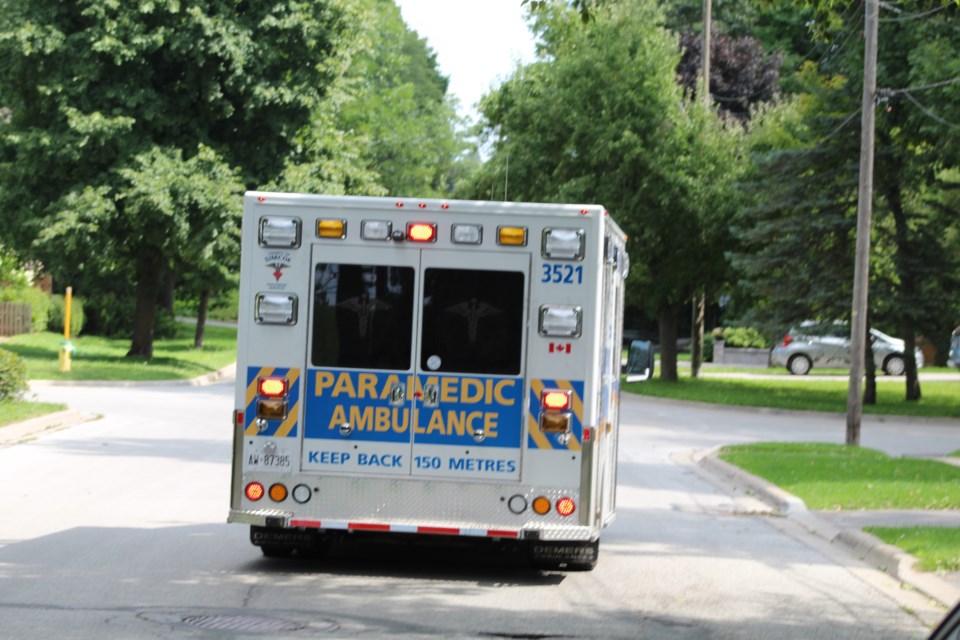Provincial funding for paramedics is not exactly keeping up with the inflationary pressures, or the services being provided, Simcoe County councillors were told this week.
County of Simcoe Paramedic Services (CSPS) received notification on Aug. 23 of the annual provincial grant funding for 2024 in the amount of $31,409,881, according to a report from director and chief Sarah Mills.
That funding represents an increase in funding of $1,732,068 from 2023, she said, and results in an overall Ministry of Health funding level of 45.4 per cent of total approved expenditures in 2024.
However, it falls short of 50 per cent funding by more than $3 million, Mills noted in her report.

In the letter from Health Minister Sylvia Jones, CSPS was informed the ministry will provide the county up to $1,674,917 in additional base funding, as well as up to $57,151 in one-time funding in relation to the land ambulance services grant for the 50/50 partnership in 2024.
That brings the total maximum funding available under the 50/50 agreement for 2024 to $31,409,881.
The ministry provides an annual operating subsidy to upper-tier municipalities across the province, with a commitment to cover half of the eligible expenses to provide paramedic services, explained Mills.
Since this service was downloaded by the ministry in 2001, funding formulas have varied, she added.
“Beginning in 2019, the ministry has based their funding formulas on 50 per cent of approved budgeted expenditures of the previous year for the delivery of paramedic services," Mills said. "At this time, the ministry stopped applying an annual cost-of-living incremental factor … and this does not consider any enhancements in service for funding until the subsequent year.”
Jane Sinclair, the county’s general manager of health and emergency services, said the funding model for paramedic services is an "ongoing issue."
"In essence, we are always one year behind," she said at Tuesday's county council meeting. "The announcement for our 2024 funding is based on the approved budget from 2023 by county council. Not only does it not recognize any enhancements for 2024, it does not include any consideration for year-over-year inflationary factors."
Sinclair said the county continues to urge the province to look at its "funding methodology and consider both inflationary and enhancements in the funding model.”
Response times improving
County council also heard from staff about how the service intends to go about establishing the recommended 2025 response time performance targets, which are based on performance data results, following implementation of the county’s new Medical Priority Dispatch System (MPDS).
The Ontario Ambulance Act mandates that paramedic services report response-time performance targets for a given calendar year to the ministry.
Analysis of the data identifies year-over-year improvements in 2023, followed by an upward trend in response-time performance during the first half of 2024, Mills stated in her report, noting a plateau in cardiac-arrest response times.
The County of Simcoe’s 90th percentile response-time mandate was set at 15 minutes, said Mills, adding a significant improvement was noted in five of the six categories in 2023 compared to the previous year’s data.
“In 2022 and 2023, factors contributing to this response-time trending included increases in call volume, staffing instability, increased offload delay and greater patient complexity, reflecting longer scene and patient care times," she said. "The transitional and stretch targets, being higher than historical performance, have also contributed to trending in actual response times versus established targets."
The 90th percentile response time for the first half of 2024 is 13:19 minutes, which is a 39-second improvement. Also, five of the six provincially reported response-time standards have shown marked improvement over the 2023 results.
“At this time, two of the six targets are being met for 2024,” said Mills, noting while response time to cardiac-arrest calls has improved in 2024, given the increased number of calls, the overall percentage of combined responses under six minutes from paramedic and firefighters currently remains below the annual target.
Staff anticipate additional progress toward the 60 per cent target in the last two quarters of 2024, said Mills, adding with the recent implementation of MPDS staff anticipate the improved call prioritization will increase ambulance availability to respond to cardiac-arrest calls.
“CSPS is trending in a more positive direction. Impacts associated with increasing complexity of medical calls, overall workload, system-wide health human resource shortages and hospital offload times continue to influence performance to target outcomes," she said.
“We are meeting two out of the six with the new dispatch system and hopefully that will improve our times,” Bradford West Gwillimbury Mayor James Leduc said during Tuesday’s meeting.
Staff have recommended maintaining the 2025 response-time performance targets.
“Given the improved trending noted in 2024, continued efforts to stabilize health human resources, and anticipated improvements in offload delay challenges, staff will continue to strive to meet these targets in 2024,” said Mills.
The implementation of MPDS will have a direct impact on cardiac arrest and Canadian Triage Acuity Scale (CTAS) one and two response times, she added, leaving more vehicles available to respond to these high-priority calls and assigning the best unit to the remaining CTAS category three, four and five calls.
Mills also said it’s expected that ministry reporting on response times will change when all provincial ambulance communication centers switch over to MPDS.
